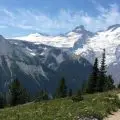Hey! This site is reader-supported and we earn commissions if you purchase products from retailers after clicking on a link from our site.
Years ago when I was working in the hospitality industry and had a 9 to 5 job with the standard two weeks of vacation per year, I would try to maximize that time by filling my itinerary with every attraction or place that I wanted to go and usually I would come home more exhausted than when I left. These days however, I tend to roam on back roads and avoid places like water parks and amusement parks with too many people and over-priced food and beverages. I also prefer to boon dock over campgrounds because I really don’t like being around places that are packed with people.
Why You Can’t Just Rely on Google Maps
There are numerous resources for an RVer that is looking to plan a route and of course Google Maps is a good way to begin. While this is a good resource, it (like similar mapping sites) will always give you a direct route by way of the most convenient and fastest route possible. This doesn’t work for me though, and I’ll explain why. Let’s say I’m in Miami, Florida and I want to travel Marquette, Michigan. Google Maps will direct me to take I-75 from Miami all the way up to Michigan’s Upper Peninsula where it would then advise to drive west on a state highway known as M-28 which will take me directly to Marquette.
While this may work for most people, it won’t work for me because I don’t want to drive 1200 miles on the same interstate. As I said earlier, I prefer to drive the less traveled road so I started by looking up the place that I am leaving to see what smaller roads I can take, and in this case, I discover that U.S. 41 begins in Miami and ends just north of Marquette. I then will research that route and here I discover that U.S. 41 will take me through quaint little coastal towns along the Gulf of Mexico in Florida. I also discover that it will take me on a scenic route through the mountains in Tennessee and when I reach Wisconsin I will once again be driving along a coastal road by Lake Michigan. On this route, I am not driving through mountainous regions with semi-trucks trying to pass me at 75 miles per hour. Instead, I am driving through small towns and villages, farming areas and national forests.
Using Road Atlases
When my route may take through larger metropolitan areas that I am not interested in seeing, I will often reference my Rand McNally road atlas to find alternative roads to bypass that area. I like to look at maps as opposed to a small screen on a cell phone or a GPS monitor so this always works best for me.
Now That I’ve Decided on My Route, What’s Next?
That’s a question that really all depends on what you want to do or see. I always start out a new journey by planning where I might want to stay along the route. I don’t plan that out for the entire route in one day, instead I will look ahead to where I might think I want to spend a night or two and when I get there, I will then look into where I want to stay for a few days farther north, and so on. This way I feel as if I am not rushing myself. Sometimes if I really like a spot I may stay a week and explore the area and other times I may stay one night. My shorter stays are usually at campgrounds because I prefer to stay where it’s free or reasonably priced. If a campground has a pool, a camp store, playgrounds, and game rooms, I tend to pass them by as well. I do this also because I prefer a little more solitude than most people probably do but that’s not say that I never stay at campgrounds because I do and I have stayed at some very nice ones as well.
How Do I Find a Campground That I Will Like?
Again, that’s really up to you. What do you enjoy doing? For example, I like to fish so I will do a search for campgrounds along my route that may be located on lake or river and allow you to fish. Some may even have a boat ramp or boat rentals. I stayed at one campground that was aimed at fishermen, not only did they have a lot of amenities, but they also had a bait shop and sold fishing licenses on site.
AllStays.com
To search for campgrounds that you enjoy, I like to use the website allstays.com, they have over 30,000 campgrounds listed in their directory and you can search for a campground based upon interest, amenities offered, or technical issues. Let’s say for example, that you are traveling in a Class A motorhome and you are towing a vehicle and your motorhome needs a 50 amp power source – this website lets you look up that information and will recommend those campgrounds in their directory that match your requirements. They also have a free mobile app that is well worth downloading so that you can more readily access their information while you are rolling down the road.
How Do I Find Free Campsites?
Looking for a good free campsite can be hit-or-miss in some parts of this country and I will share some of my experiences and where the easiest and hardest places to find free camping are in a future article. For now, one good website I like to use is freecampsites.net. On this website, you can search for places to stay by location. I like to use it because it breaks down some locations by whether they are a national forest, a research facility, or even a small village park that allows you to stay overnight. It also will advise you to businesses such as casinos and places like Camping World or Bass Pro Shops that will let you stay a night in their parking lot.
My colleague Lindsey also wrote a great column on her favorite campsites near National Parks, which is worth reading.
Final Words
Now that you have planned your route and itinerary, it’s time to get moving down the road. Just remember, as a full-time RVer, you don’t necessarily have to move at great speed. Constantly moving from one place to another on a tight schedule can be stressful. Take your time and enjoy the journey.




